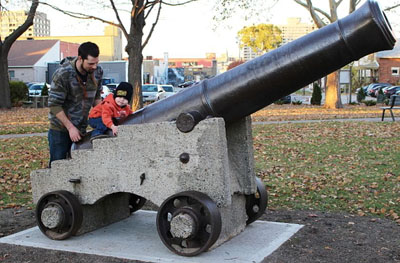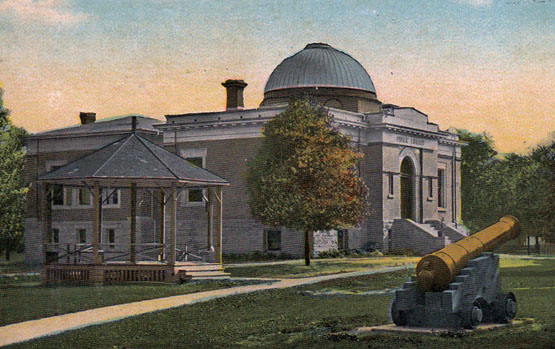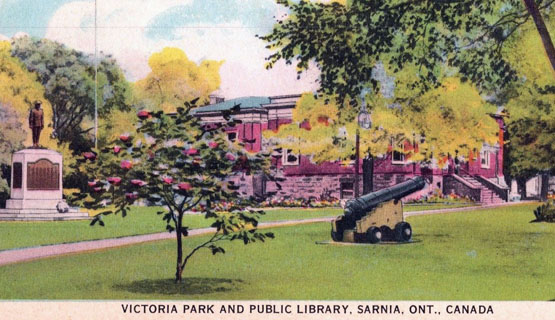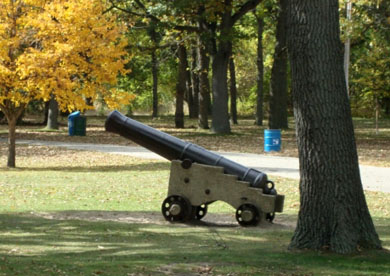|

 CRIMEAN CANNONS - WHERE ARE THEY NOW?
CRIMEAN CANNONS - WHERE ARE THEY NOW?
Veterans Park
Sarnia
Ontario
Canada
ON N7T 2S9
Robins Russian cannon database records a single cannon here without giving details other than possibly scrapped. Research in the second decade of the 21st century suggests that this is misleading.
A cannon known as Big Tom had been located at various sites in Sarnia over the decades but there was an absence of knowledge about its provenance. Then in 2014, George Mathewson authored a historical summary. It was in May 2014 that the following information appeared in the local paper, The Sarnia Journal.
The article noted that the cannon had been climbed on, posed beside and rendezvoused at by half the people in Sarnia at one time or another. But the origins of the cannon then in Canatara Park, and how it got there, have long been a mystery. Now, two men researching Sarnia's war history have unearthed new evidence that sheds light on the story of Big Tom, as the gun is known.
Tom Slater, a retired St. Patrick's High School teacher the previous year had released The War Remembrance Project, which gathered the names of fallen local soldiers. Subsequently he updated and expanding the book with research help from Sarnia's Randy Evans.
It had been indicated that there was once a cannon in Veterans Park and they wondered why it wasn't there any more. There were two theories about Big Tom. According to a short history of Veterans Park (formerly Victoria Park) the cannon was used during the Crimean War (1853 -1856). However other references suggest it came from the British gunboat Prince Alfred, which went aground in Lake Huron somewhere near Point Edward in 1874.
According to the latter story, the ship was sold to the U.S. and the cannon removed and stored in the military reserve base at Point Edward until 1879. The gun was then moved at some point to Veterans Park, near the Sarnia Library, a traditional marshaling ground and send-off point for troops. This relocation is confirmed in the vintage picture below.


Historian Randy Evans however then unearthed archival records in the Milwaukee Public Library that indicated the Prince Alfred was a Canadian gunboat, and that it was actually built in Sarnia in 1859. Evans also took measurement of the cannon and found its specifications match those of the British '68-pounder' cannons used against the Russian in the Crimean war. Putting all that together Evans came up with a hybrid explanation.
He concluded that it was a Crimean-era gun. It may or may not have been used in the war, and it came over from England to Canada to help refit a colonial gunboat. The gunboat it ended up on was the boat made here in Sarnia. The dates certainly fit. According to British naval records, the Prince Albert was equipped with two Armstrong and four brass howitzer guns which were used to train volunteer landsmen in 1871-72. This Sarnia-built vessel had a succession of private, government and company owners in Canada and the U.S. It was eventually broken up and the register closed on May 25, 1885. Big Tom disappears for while about this time.
Ottawa is Canada's capital, in the east of southern Ontario, near the city of Montreal and the U.S. border. In the 1940's the federal government in Ottowa planned to recyle Big Tom for the war effort. Local residents fought back, saying it didn't belong to Ottawa because it was in Point Edward prior to Confederation.
Then the cannon was moved again, to Canatara Park from the Veterans Park downtown. That happened sometime between 1959 and 1961 in preparation for the current Sarnia Library building.
This 2014 summation of the cannon's history was not the end to the matter however as local interest in the cannon escalated. Sarnia's
Big Tom cannon clearly had a fascinating history, and is likely one of the oldest historical objects in the city, according to local historians Lou Giancarlo and Tom Slater. These two historians were members of the Relocation of Big Tom Committee that successfully got the cast-iron cannon moved from Canatara Park back to Veterans Park in 2015,
They determined that Big Tom's story began around two centuries ago, when it was manufactured by Rotherham-based English artillery maker Walker and Company, during the reign of King George III. Walker and Company was a massive operation, having a labour force of around 1,000 men, and the company made tens of thousands of cannons each year for the British Empire, which was involved in numerous conflicts at the time, including the Seven Years War, the Battle of Trafalgar and the American Revolutionary War.
The royal marking, or cypher, on Big Tom confirmed that the cannon was made during the reign of King George, which lasted from 1760 to 1820. Further research indicated that the cannon was designed by Thomas Blomefield, England's Inspector of Artillery and Superintendent of the Royal Brass Foundry, whose designs started being produced in 1787. Big Tom was manufactured between 1787 and 1820. In technical terms, Big Tom was known as a Blomefield SBML 32-pounder (shell size) 56-cwt (imperial weight) cannon.
In the mid 1860s, Irish nationalists sought independence from England. This led to conflict in some areas in the colonies. In Canada there was a real threat of Irish Fenians coming into Canada from the United States.
The British were preparing for such an invasion. Militias were formed, money was raised for the defense of the colony and cannons were deployed to Canada for defensive purposes. Big Tom was deployed at Point Edward to defend the colony here. Then it was placed on a retrofitted ferry-turned-gunboat, the Prince Alfred in 1866, in its role as a 288-ton gunboat patrolled the Great Lakes during the days of Fighting Tom Sweeney's Fenian Irish Raids circa 1866.
As the Irish threat subsided, the cannon was eventually moved off the ship and transported to the military reserve base in Point Edward, where according to articles in the Observer, it sat and gathered moss, covered in sand and underbrush until the town of Sarnia bought the cannon then known as Long Tom in 1869.

The town subsequently placed the cannon in what was then known as Port Sarnia's Market Square (later Victoria Park, now Veterans Park), using it as a potent and solemn symbol of military sacrifice, where it sat until 1959. The above picture captures it in the park circa. World War II.
Further investigation also confirmed that in spite of its revered place in Sarnia, Big Tom's presence in the city became threatened during the Second World War as detailed above. The federal government was looking for scrap metal. Such was Big Tom's status among townsfolk that local citizens banded together to keep the monument where it was. It was during this war time period that the cannon previously known as Long Tom underwent an accidental name change and began being known by the moniker of Big Tom. In 1942 someone thought to be from the Observer, first started calling it Big Tom and so it turned out it was a newspaper reporter who renamed it Big Tom, probably inadvertently. This name has stuck and we have used it throughout this summation to avoid further confusion.

In 1959 or 1960 Big Tom was moved from its original 90 year home in Veteran's Park to Canatara Park, due to the construction of a new public library on Christina St. The cannon then remained in Canatara Park for over 50 years. Big Tom finally returned to its rightful home in Veterans Park in early November 2015. The revitalization of Veteran's Park began a year before with the addition of poppies near the cenotaph for the anniversary of the war of 1812. Ever since then, the Big Tom cannon has once again been a feature within Veteran's Park.
ADDITIONAL INFORMATION

FACILITIES
Access all Year, Access by Road, Access on Foot, Part of a larger tourism attraction
LANDSCAPE
City Centre, Park or Garden
REGION
Located outside the United Kingdom
THE FEATURES PRESENT
Crimean Cannon Location, past or present
|









